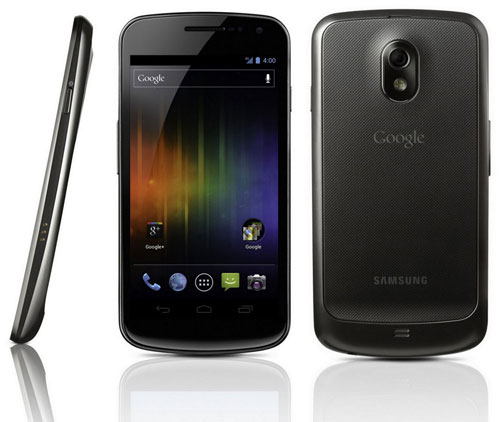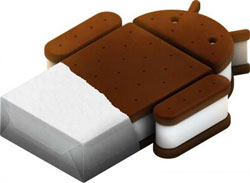
Samsung’s Galaxy Nexus, the first smartphone device running Android 4.0 (the oddly named Ice Cream Sandwich), lands on SA shores in the next few months. TechCentral got early access to the Galaxy Nexus and put the device through its paces. Apart from one major problem (more on that later in the review), we were blown away.
They say first impressions count and, with the Galaxy Nexus, it was love at first sight. Clad in a “titanium silver” shell (the colour of our review model), the 145g phone is gorgeous — especially its vivid, 4,65-inch curved Super Amoled capacitive-touch screen that offers up a resolution of 1280×720 pixels.
Samsung has packed in the very latest hardware into the Nexus, including a fast-reacting HD video camera that can take still images at 5 megapixels (the front-facing camera is 1,3 megapixels), a 1,2GHz dual-core processor, TI OMAP 4460 chipset, near-field communication (NFC) technology built into the battery, gyroscope, accelerometer, compass and, wait for it, barometer. Although the SA version doesn’t support next-generation wireless networks based on long-term evolution, the local model comes with a superfast, 21,6Mbit/s antenna system.
There’s also 32GB of internal storage, most of which is available, and the usual connectivity options such as Bluetooth and Wi-Fi. The 1 850mAh battery delivers fairly pedestrian performance, especially if you keep that large screen alive for an extended period. Expect to carry a charger in your bag because chances are you won’t make it through a day of heavy use. Its battery life is no worse than other smartphones in its class.

But it’s the screen and the new version of Android that really make the Nexus stand out from the crowd and result in a device that can mount a serious challenge to Apple’s iPhone 4S as king of the smartphones. It’s without doubt the best Android device we’ve seen, even better than Motorola’s new Razr and the HTC Sensation.
The version of Android on the Nexus is devoid of any “skins” smartphone manufacturers such as Samsung and HTC love to add to the vanilla software. And that’s a good thing given that Samsung’s TouchWiz, in our view, makes the company’s phones less pleasant to use. Ice Cream Sandwich is a gorgeous operating system out of the box, so why tinker with what works so well? The only user interface we feel improves on the basic Android software is HTC’s Sense.
The Nexus is the first Android phone to feature “virtual buttons” in the user interface, rather than physical or capacitive-touch buttons. This means they “disappear” when you’re watching video. They also reorientate themselves if you flip the phone on its side.
The software also allows the user to put folders on their home screens to reduce icon clutter and it has better voice integration, though it’s nowhere nearly as good as Apple’s Siri software on the 4S. The new version of Google Talk is also impressive, though we prefer Trillian for cross-platform support. The Web browser is also greatly improved in Ice Cream Sandwich, but again we prefer Opera Mobile simply out of personal preference.
Particularly pleasing is that the Google Music is included in Android 4.0 as a preinstalled application, and given how easy it is to fool the service into thinking you’re in the US, it’s a great addition. It’s particularly useful given that Samsung has opted not to include an FM radio with the Nexus.
Another new feature is Face Unlock, which allows you to take a picture of yourself and use the software to remember you. Simply stare at the face of the phone and it will recognise you — most of the time — and unlock itself. It’s still a bit gimmicky, though, and we quickly turned off this option.

Then there’s Android Beam, which allows users with NFC-enabled phones to “beam” video, music and other content between their devices. Since there are so few phones with NFC support in the market, we can’t see this feature being a big hit. Not yet, anyway.
As a voice phone, the Galaxy Nexus is not perfect. Voice calls are a little tinny, though the speakerphone is reasonable.
In terms of form factor, the Nexus is big. We think people with small hands won’t be able to operate the phone with one hand. But it’s not as big as the 5,3-inch Samsung Note, which, we felt, was too big to be usable as an everyday phone. The Nexus’s 4,65-inch screen is about as big as smartphones should be. Some users may prefer something a little smaller.
Our only big gripe with the Galaxy Nexus is its apparent fragility. We accidentally dropped it onto a hard-top kitchen counter from a height of about 20cm. The result was a small hairline crack at the bottom left of the screen that rendered it useless. Fortunately, we’d used it enough to compile this review, but it is worrying that the screen broke quite so easily. We’ve meted out much tougher punishment on other smartphones and they’ve survived without any problems, so do bear this in mind.
Samsung Galaxy Nexus promotional video (via YouTube):
Despite this, if you absolutely must have the latest and greatest Android phone, the Nexus is for you. In the first half of next year, of course, there’ll be dozens of Ice Cream Sandwich models in stores, so if you don’t feel the urge to splurge right away, then it’s better to wait to see what competitors’ offerings look like.
Inevitably, parallels will be drawn between the Nexus and the iPhone 4S. Which one is better? That’s a hard call to make and is ultimately a matter of personal preference. However, Google has made great strides with Android 4.0 and, coupled with the great hardware in the Galaxy Nexus, it’s no longer an easy choice to make. If you do get the Nexus, just be sure you don’t drop the darned thing. — Duncan McLeod, TechCentral
- Price: From R6 999 without a contract
- Subscribe to our free daily newsletter
- Follow us on Twitter or on Google+ or on Facebook
- Visit our sister website, SportsCentral (still in beta)




